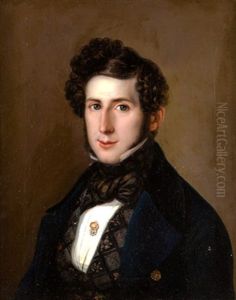Jose de Madrazo Paintings
José de Madrazo y Agudo was a renowned Spanish painter, born on April 22, 1781, in Santander, Cantabria. He was an influential figure in the Spanish art scene of the 19th century and served as a bridge between the neoclassical and romantic styles of painting. Madrazo received his initial art education at the Real Academia de Bellas Artes de San Fernando in Madrid. His talent was recognized early on, and he was awarded a scholarship to study in Paris, where he worked under the tutelage of Jacques-Louis David, the leading French neoclassical painter of the time. Under David's guidance, Madrazo honed his skills and absorbed the neoclassical principles that would heavily influence his work.
Madrazo's stay in Paris was followed by a period in Rome, where he continued his studies and began to make a name for himself as a painter. In Rome, he was influenced by the Italian masters and the rich artistic heritage of the city, which would play a significant role in the development of his style. Madrazo's work is characterized by a strong classical influence, with an emphasis on historical and mythological themes, and a meticulous attention to detail.
Returning to Spain, Madrazo quickly established himself as a leading artist and became a court painter to King Ferdinand VII. He was also a founder and later director of the Real Museo de Pinturas y Esculturas, which is now known as the Museo del Prado in Madrid. His position allowed him to play a crucial role in the development of the museum's collections and the promotion of the arts in Spain.
Apart from his achievements as a painter, Madrazo was a key figure in the Spanish artistic community, serving as a mentor to younger artists and influencing the direction of Spanish art. He was also the patriarch of a dynasty of artists; his sons Federico de Madrazo, Luis de Madrazo, and Raimundo de Madrazo, as well as his grandson, Raimundo de Madrazo y Garreta, all became accomplished painters.
José de Madrazo y Agudo's legacy is marked by his contributions to the Prado Museum, his role in fostering the arts in Spain, and the continuation of his artistic lineage through his descendants. He passed away on May 8, 1859, in Madrid, leaving behind a body of work that continues to be studied and appreciated for its historical significance and artistic merit.




